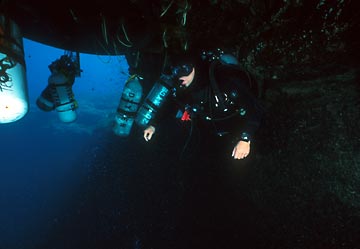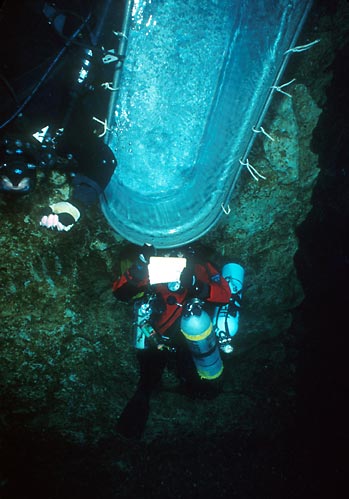The Varying Permeability Model: A Decompression Razor
The Varying Permeability Model: A Decompression RazorBY DR. ERIC MAIKEN
DETAILS OF THE VPM Microscopic bubble nuclei have been observed in many types of aqueous (water-containing) media under equilibrium conditions. The VPM therefore presumes that even prior to beginning a dive, with the non-equilibrium cycle of compression and decompression, these nuclei also exist in a diver's tissues. VPM decompression procedures are designed to eliminate bubbles that grow from these seed nuclei as well as gas that is dissolved in the diver's tissues. The term "Variable Permeability" refers to the different responses of bubble nuclei to pressurizations encountered on dives deeper than approximately 9 ATA, compared to shallower dives. On deep dives, nuclei are thought to become impermeable to the flow of gas, and the VPM generates more conservative tables for these deeper dives. The VPM postulates that as a diver ascends, nuclei larger than a specific "critical" size, which is related to the maximum dive depth, descent rate, and breathing mix, will grow upon decompression. The VPM aims to minimize the total volume of these growing bubbles by keeping the external pressure large (through deep stops), and by keeping the inspired inert gas partial pressures low during decompression. The VPM uses an iterative procedure to refine decompression schedules. In each iteration step, a new ascent schedule is calculated. The total decompression time is fed back into the calculation to revise the critical gradients, and a more liberal schedule is produced at each step. This process repeats until the decompression time converges to a length that corresponds to the formation of the maximal allowable amount of free gas bubbles. The total decompression time depends on the contributions of the magnitude of the growth gradient and the time that the gradient acts to drive bubble growth. After a short dive, the tissues will off-gas rapidly to circulation. Hence, because the time that the gradient G acts is small, the magnitude of G can be increased in each VPM iteration to allow shorter and shallower stops. So, for short or no deco dives, the first and last iterations produce substantially different ascent schedules. A divergence of the VPM from conventional calculations is in the details of how a diver's ascent is controlled. Rather than setting predefined limits (like M-values) on the maximum pressure ratio between gas dissolved in tissues and ambient pressure, ascents are limited by gradients that depend on specific details of a particular dive, which include factors such as depth, gas mix, and descent rate. The objective is to control the volume of gas that evolves in the body due to the inevitable formation of bubbles. As long as this volume is kept smaller than a certain "critical volume," it is presumed that a diver's body has the ability to tolerate the bubbles. If the volume of bubbles exceeds the critical volume, then the diver is at risk of developing DCI. VPM decompression computations handle the in- and out-gassing of dissolved gas in a set of compartments the same way as standard dissolved gas algorithms. However, the VPM does not associate individual compartments with specific organs or tissues in the body. Parallel compartments with exponential half-times ranging from minutes to hours are used to model the body's range of time scales governing the uptake and elimination of dissolved inert gas. This is simply a method for replacing the complex reality of human metabolism under pressure with a tractable set of metrics that span the space of the body's response time scales to pressurization and depressurization. There has been a tendency for vendors of commercial decompression software to market a large set (say, more than 16) of compartments as an enhancement to their products. This dubious exercise is counter to the responsible modeler's objective of minimizing the free parameters that relate a system's responses to measurable inputs. Whether you abide by Ocam's razor, Hogarth, or K.I.S.S., a deco modeler's guiding principle should be to eliminate arbitrary and unnecessary parameters. Towards these ends, the VPM differs from conventional dissolved gas algorithms by replacing the ascent-limiting matrix of M, or a-b values, with only five constants for mixed gas single dives, and seven for repetitive dives. These quantities correspond to measurable physical and physiological quantities, and are used to limit ascents by specifying critical over pressure gradients. In contrast to conventional M-values, which have no direct physical interpretation, gradients are related to linear gas transport and to the rate of bubble-growth via the diffusion equation.BENCHMARKING THE VPM
If an ascent made with a closed oxygen window is compared to an ascent made with high ppO2 deco mixes, then not only are the stops with high ppO2 mix shortened, but so also are the preceding deeper stop times for the low ppO2 ascent. There is no analogy to this effect in a supersaturation calculation (where only the stop times when the mix is breathed are reduced). This is an artifact of the iterative procedure used in the VPM model. Because the dissolved inert gas will wash out faster when high ppO2 mixes are used in shallow stops, the total deco time is reduced-- thereby reducing all of the stop times. Practically, it is prudent to plan deco only for gas supplies that can be guaranteed to be with the diver during ascent. Oxygen toxicity must be preeminent in dive planning. A DCI incident is inconvenient, whereas a toxicity-hit is final. Within toxicity limits, it's best to open the O2 window as wide as possible and as early as possible in the ascent (keep ppO2 high). However, given a limited number of stage gases, and short deep stop times, remember that because the volume of bubbles depends on growth time, one shouldn't sacrifice high ppO2 on the longer shallow stops for an early switch. Inert gas management is also important, withÊlong decompression dives favoring high helium content in decompression mixes to take advantage of the fast desaturation rate and deep no deco saturation depth.MIXED GAS AND THE VPM Extension of the VPM algorithm to Trimix (or multi-inert-gas) diving was done by fractioning the in- and out-gassing of inert gases in compartments as originally described by H. Keller, who was responsible for the algorithms employed by A. Bühlmann. Weighted critical ascent gradients are formed from the partial pressures of the inert gases, and a numerical method is employed to keep the sum of the helium and nitrogen partial pressures less than the critical gradient. Although this is a conventional procedure for modeling multiple inert gasses, the physiological and physical basis of this technique is somewhat dubious because both helium and nitrogen diffuse into bubbles independently--yet the rates of transfer of each gas are coupled through the dependence of bubble pressure on bubble volume. YOU ARE THE FUTURE OF THE VPM With the ready availability of technical details of VPM algorithms, open source code, and freeware decompression programs, divers have essential information available to them to make judgments and modifications on this new set of decompression procedures. The VPM model is considered by many diving practitioners of deep-stop-driven ascents to be a more robust and accurate analog to physiological processes occurring within the body compared to conventional methods. After all, if you can't decompress Jello™, how can you expect to ascend from a frontier level dive? Further benefits, including greatly shortened ascent times, as well as cleaner decompressions, potentially arise from VPM-based methods. This holds true especially in cases where dives are made far beyond the tested limits of conventional procedures, where the grounding of the VPM in basic scientific observations provides leverage for extrapolation. Deep stops and the related VPM modeling continue to peak the interest of technical divers everywhere. As individuals continue their quest to obtain a reasonable approximation of decompression procedures, one can hope that continued explorations offer a sound, repeatable, and trouble-free calculation scheme. Nonetheless, in this early stage of deployment of the VPM, caution is the word. It is advisable to plan dives for ample deco and only rely on the enhanced safety of initial deep stops or theoretically shorter ascent times for insurance. For example, in the case that a direct ascent to the surface is required due to a hazardous operational situation or other emergency, you have a built-in safety backup through making an optimal ascent every step of the way home. REFERENCES (1) D.E. Yount, D.C. Hoffman, On the Use of a Bubble Formation Model to Calculate Diving Tables. Aviation, Space, and Environmental Medicine, February 1986. (2) D.E. Yount, E.B. Maiken, E.C. Baker, Implications of the Varying Permeability Model for Reverse Dive Profiles, AAUS, January, 2000. http://www.decompression.org/maiken/VPM/rdpw.pdf (3) D.E. Yount, E.B. Maiken, E.C. Baker, A New VPM Algorithm for Repetitive Dives, UHMS, June, 2000. http://www.decompression.org/maiken/VPM/ VPM_Repetitive_Poster.ppt
Copyright ©2004 Global
Underwater Explorers.
All rights reserved. |



